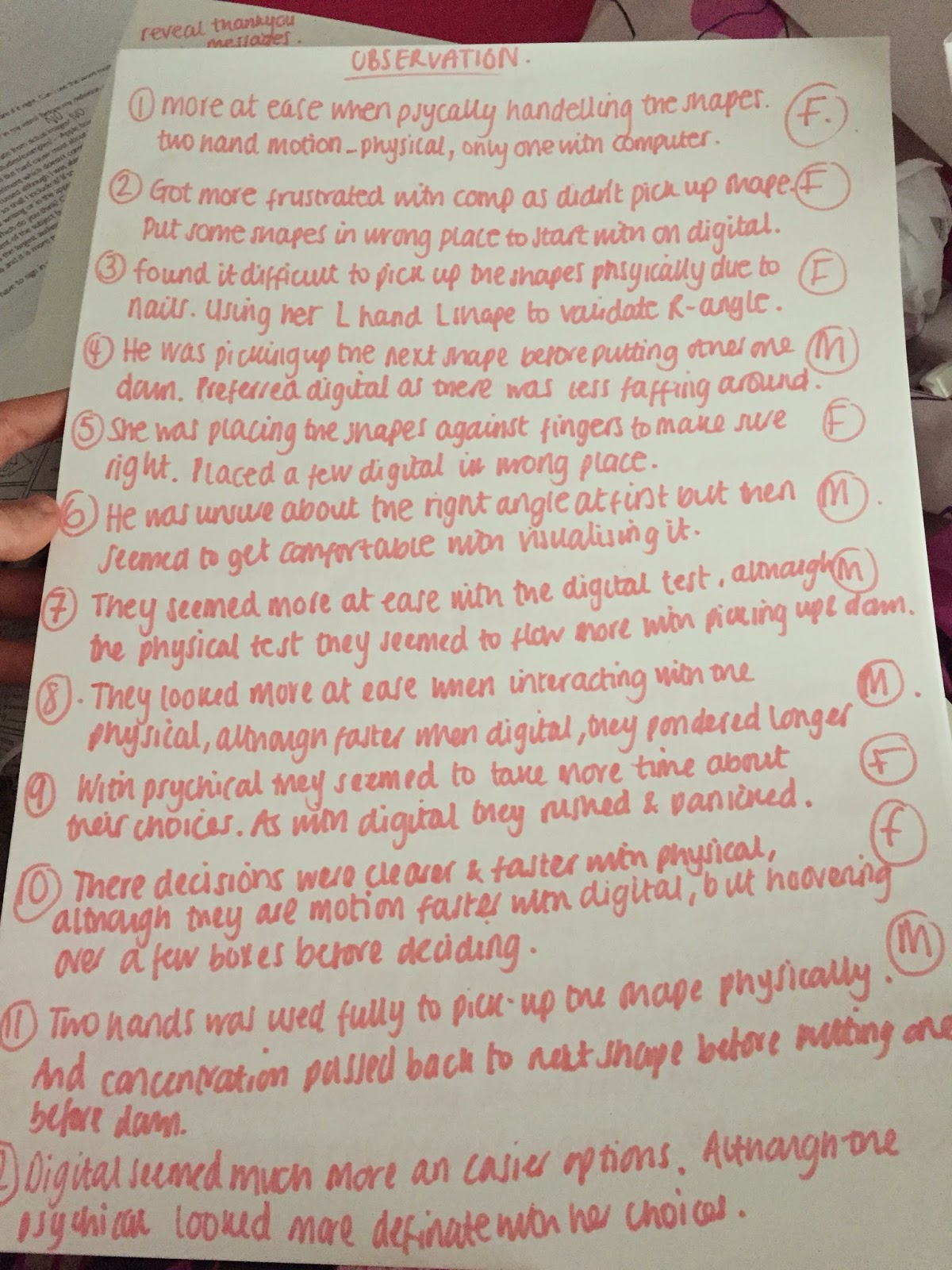This is the email i sent to and all the different email addresses I sent it too...
I didn't receive any replies for quite a while and then I received one back from mark at the engine room...
I was very dissapointed that I only received one email and felt quite dissapointed and disheartened.
So then I decided to do more primary research and I carried out an experiment to see which medium gave the best result for a simple task....
Methodology
This is an experiment
carried out due to wanting an understanding whether physical and digital
objects differ within interaction level and learning styles. The experiment
consisted of completing a simple task of shape sorting with the two different
medias. To get a fully honest outcome it was vital that a task was chosen, that
would be at the same level with both medias. The task made them to stimulate
their minds to recognise the amount of right angles the shape has to put it in
the correct category.
The key variances between
the two tasks of digital vs. physical, is that there was a lack of ability to
hold and focus on one shape at a time within the 3-dimentional environment with
the digital condition compared with the lack of multimodal feedback within the
physical task. This allowed focus on how the changes between each condition
influenced the speed of interaction.
The tasks were documented in
two forms. Firstly, the times where noted and then the difference in times
between the two tasks was noted. Then an observation was recorded in terms of
movement and anxiety etc. Followed by a simple question was asked of which one
they preferred and why? Throughout this experiment have used a parallel data
gathering. This combination of both quantitative and qualitative data will
allow informative feedback and can give me a stronger evaluation
by ensuring that the limitations of one type of data are balanced by the
strengths of another.
There were 12 participants
in the study, 6 female and 6 male, all from technical and non-technical
backgrounds. All participants had no prior knowledge to the assessment.
In the study 3 female and 3
male participants completed the physical condition first. Then the rest of the
participants completed the digital condition on a laptop first, they then all
swapped to play the opposite condition. The physical condition has three
categories, which was arrayed at the side of each other, the activity was
explained and they was told they had to complete the task as quickly and
accurately as possible, but no time limit was given. The digital condition
also has three categories, which are placed in the same order as the physical
stage, they was told the same breakdown and explanation about the task as the
physical condition, this was to try and control as many variables as possible.
Results of the experiment
have shown that people prefer the interaction physically better than when your
engaging on a screen, but the task is completed faster when completed digitally
overall rather than physically. The average of the digital interaction task was
18.18 seconds, whereas physical interaction task was completed in 19.38
seconds. Therefore this is just over one second longer, which is not much of a
difference, compared to the large motion of the physical interaction compared
with the small movement of hands within the digital task. The choice of timing
the task was a decision based on the ideology that it would give an estimate of
how fast the brain was functioning, therefore resulting in quantitative data.
Due to the parallel data
gathering, qualitative data was also collected through observation and question
and answer stage at the end of the experiment with the participants. From
observation, it was noted that the participants looked more at ease when taking
the physical task, this was devised from their body language. They seemed to be
ambidextrous during the physical task as then they placed one down they would
pick up the next shape with the opposite hand, this is saving time and
familiarising themselves with the task. This means they have successfully pass
the adaptation time of the creative engagement model. Thirdly, the participants
that had recorded that they had regular contact with computer interaction were
more effective on the computer. This maybe due to their bodily adaptations,
that they have become accustom to as they may need to complete similar tasks on
a daily basis. Finally, another main observation that was made, is that when
taking part in the physical task the participants were using their hands a tool
to test the question, whereas with the digital task this was a harder decision
due to the lack of ability to be able to focus on one shape at a time.
The last stage of this
experiment was a question asked to the participants straight after they had
finished the second task. This was which task they preferred taking into
account, their feelings when partaking and from their reflections upon the task
now. From this seven participants said they preferred the physical task
compared to the digital. And three participants said they preferred the digital
task. The other two believed there wasn’t much preference at the time in
question.
The results of this
experiment, have shown that timing is not a good accurate reading for means of
measuring the levels of engagement & brain function, a better way of measuring
this would have been using a brain monitor to see when the brain processes the information
given. This would have been a more effective way if feasible due to no
interruption due to the single connection. This is due to other variables affecting
the results due to having many factors between the output and the recording
skill.
Results






No comments:
Post a Comment